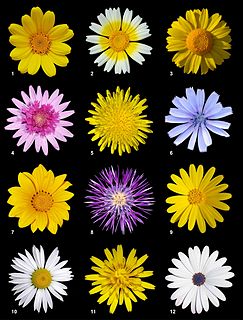
The family Asteraceae, alternatively Compositae, consists of over 32,000 known species of flowering plants in over 1,900 genera within the order Asterales. Commonly referred to as the aster, daisy, composite, or sunflower family, Compositae were first described in the year 1740. The number of species in Asteraceae is rivaled only by the Orchidaceae, and which is the larger family is unclear as the quantity of extant species in each family is unknown.

The Mascarene Islands or Mascarenes or Mascarenhas Archipelago is a group of islands in the Indian Ocean east of Madagascar consisting of the islands belonging to the Republic of Mauritius as well as the French department of Réunion. Their name derives from the Portuguese navigator Pedro Mascarenhas, who first visited them in April 1512. The islands share a common geologic origin in the volcanism of the Réunion hotspot beneath the Mascarene Plateau and form a distinct ecoregion with a unique flora and fauna.
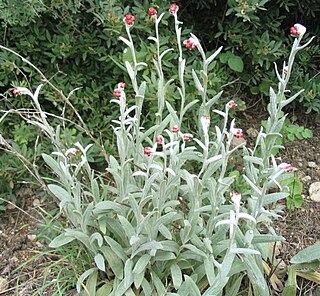
The genus Helichrysum consists of an estimated 600 species of flowering plants in the sunflower family (Asteraceae). The type species is Helichrysum orientale. They often go by the names everlasting, immortelle, and strawflower. The name is derived from the Greek words ἑλίσσω and χρῡσός.

Lactuca, commonly known as lettuce, is a genus of flowering plants in the daisy family, Asteraceae. The genus includes at least 50 species, distributed worldwide, but mainly in temperate Eurasia.
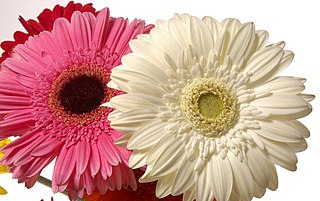
Gerbera L. is a genus of plants in the Asteraceae (Compositae) family. The first scientific description of a Gerbera was made by J. D. Hooker in Curtis's Botanical Magazine in 1889 when he described Gerbera jamesonii, a South African species also known as Transvaal daisy or Barberton daisy. Gerbera is also commonly known as the African daisy.

Inula is a large genus of about 90 species of flowering plants in the family Asteraceae, native to Europe, Asia and Africa.

Tragia is a genus of flowering plants in the spurge family, Euphorbiaceae. It is widespread across North and South America, Africa, the Arabian Peninsula, the Indian Subcontinent, northern Australia, and to various islands in the Caribbean and in the Indian Ocean.

Astereae is a tribe of plants in the family Asteraceae that includes annuals, biennials, perennials, subshrubs, shrubs, and trees. Plants within the tribe are present nearly worldwide divided into 170 genera and more than 2,800 species, making it the second-largest tribe in the family behind Senecioneae. They are found primarily in temperate regions of the world.

The souimanga sunbird is a small passerine bird of the sunbird family, Nectariniidae. It is native to the islands of the western Indian Ocean where it occurs on Madagascar, the Aldabra Group and the Glorioso Islands.

Distephanus is a genus of flowering plants in the family Asteraceae. It is described by American botanist Harold E. Robinson as having over 40 species and by David Mabberley as having only 34 species. These sources differ sharply in their description of the range of the genus. Robinson has it ranging throughout Africa and occurring also in India and China. Mabberley has it restricted to southeast Africa, Madagascar, and Mauritius.
Crassothonna clavifolia is a species of flowering plant in the family Asteraceae. It is found only in Namibia. Its natural habitat is rocky areas. It is threatened by habitat loss.
Pluchea glutinosa was a species of flowering plant in the sunflower family that was endemic to the Island of Socotra in the Indian Ocean, part of the Republic of Yemen.

Pluchea is a genus of flowering plants in the tribe Inuleae within the family Asteraceae. Members of this genus might be known as camphorweeds, plucheas, or less uniquely fleabanes. Some, such as P. carolinensis and P. odorata, are called sourbushes. There are plants of many forms, from annual and perennial herbs to shrubs and trees, and there is variation in the morphology of leaves, flowers, and fruits.

Secamone is a genus of plant in family Apocynaceae, first described as a genus in 1810. It is widespread across much of Africa, northern Australia, southern Asia, with numerous species endemic to Madagascar.

Vernonieae is a tribe of about 1300 species of plants in the aster family. They are mostly found in the tropics and warmer temperate areas, both in the Americas and the Old World. They are mostly herbaceous plants or shrubs, although there is at least one tree species, Vernonia arborea.

Oceanic dispersal is a type of biological dispersal that occurs when terrestrial organisms transfer from one land mass to another by way of a sea crossing. Island hopping is the crossing of an ocean by a series of shorter journeys between islands, as opposed to a single journey directly to the destination. Often this occurs via large rafts of floating vegetation such as are sometimes seen floating down major rivers in the tropics and washing out to sea, occasionally with animals trapped on them. Dispersal via such a raft is sometimes referred to as a rafting event. Colonization of land masses by plants can also occur via long-distance oceanic dispersal of floating seeds.
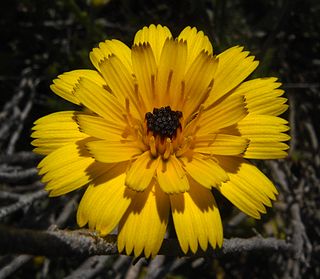
Tolpis is a genus of flowering plants in the dandelion tribe within the daisy family. It is native to Africa, Southern Europe, the Middle East and Macaronesia. Many species are limited to the Canary Islands.

Gochnatia is a genus of flowering plants in the daisy family, Asteraceae. It is named for botanist Frédéric Karl Gochnat. The genus contains mainly shrubs and subshrubs, with a few trees and herbs. All of the species are native to the American tropics. Two species native to the mountains of Southeast Asia and formerly included here are now separated as the genus Leucomeris in subfamily Wunderlichioideae.
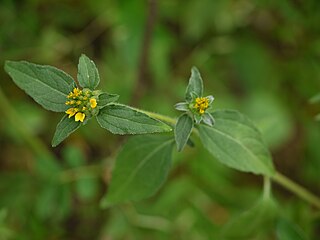
Sclerocarpus is a genus of flowering plants in the sunflower tribe within the daisy family. Bonebract is a common name for plants in this genus.
Microglossa is a genus of Asian and African flowering plants in the tribe Astereae within the family Asteraceae.

















